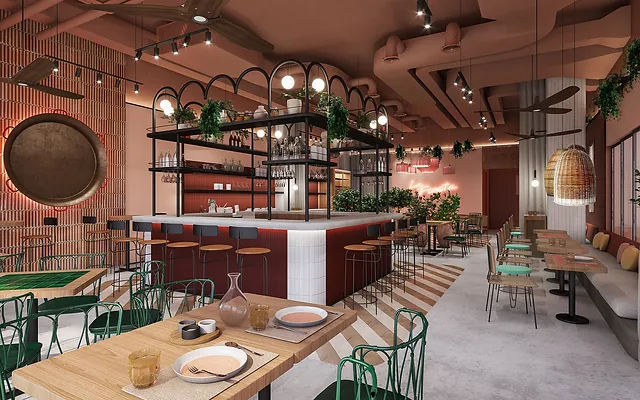In the world of dining, where food takes center stage, the role of interior design often goes unnoticed but remains indispensable. F&B design, or Food and Beverage interior design, is a multifaceted discipline that blends aesthetics, functionality, and brand identity into the spaces where we enjoy our meals. In this comprehensive exploration, we’ll delve into the significance of F&B interior design and how it profoundly affects the dining experience.
Definition of F&B Interior Design
F&B interior design is the art and science of crafting the visual and functional aspects of spaces within food and beverage establishments. It encompasses everything from the layout and furniture selection to color schemes, lighting design, and even the placement of kitchen equipment. More than just creating visually appealing spaces, it aims to enhance the overall dining experience.
Importance of Interior Design in the Food and Beverage Industry
Interior design in the food and beverage business is about creating a setting that enhances the culinary experience, not only about looks. Whether it’s a comfortable café, a noisy bistro, or a fine dining establishment, interior design shapes how customers perceive, enjoy, and remember their dining experience.
Overview of How Interior Design Affects the Dining Experience
Interior design goes beyond the surface. It sets the stage for the entire dining journey, from the moment customers step through the door to the lingering memories they carry with them. Let’s explore the key aspects through which interior design exerts its influence.
Creating an Inviting Atmosphere
A welcoming and comfortable atmosphere is the cornerstone of any successful F&B establishment. Customers seek more than just good food; they crave an experience. The clever use of colors, lighting, and furniture can transform a plain space into a warm and inviting haven.
The choice of colors can evoke specific emotions. Warm tones like reds and oranges can create a cozy and vibrant ambiance, while cool blues and greens can impart a sense of serenity. Lighting, when used thoughtfully, can accentuate architectural features, highlight food presentation, and even influence mood. Comfortable and well-placed furniture is essential for ensuring that customers can relax and enjoy their meal without distraction.
An inviting atmosphere not only draws people in but also keeps them coming back. It fosters a sense of comfort and familiarity, turning first-time visitors into loyal patrons. Customer satisfaction and loyalty are intrinsically linked to the ambiance they experience.
Enhancing the Brand Identity
F&B interior design is a powerful tool for conveying a brand’s personality and values. The design elements chosen—from the type of materials used to the layout of the space—communicate a brand’s story and image.
For instance, a rustic, wood-dominated interior may align with a farm-to-table concept, conveying a commitment to freshness and authenticity. In contrast, a sleek and minimalist design with cutting-edge technology might reflect a brand’s modern and innovative approach.
Consistency is key in branding. Interior design ensures that the brand experience is uniform across all touchpoints, be it the physical space, the menu, or the staff’s attire. It reinforces the brand’s identity, making it instantly recognizable and memorable.
Optimizing Space and Layout
Efficient space utilization is paramount in F&B establishments. The strategic placement of tables, chairs, and service areas can significantly impact the customer experience.
A well-designed layout not only maximizes seating capacity but also ensures that customers and staff can move seamlessly throughout the space. It influences customer flow, reduces bottlenecks during peak hours, and enhances staff efficiency, resulting in quicker service and a smoother overall experience.
Consider, for example, a fine dining restaurant where tables are spaced generously to allow for intimate conversations. Contrast this with a busy café, where a compact layout optimizes space and encourages turnover.
Creating a Memorable Experience
In a world brimming with dining options, creating a memorable experience is the key to standing out. F&B interior design plays a pivotal role in achieving this goal.
A well-designed interior should do more than meet the eye; it should surprise and delight. Creative and innovative design elements, such as unique architectural features, captivating artwork, or interactive installations, can elevate the dining experience to a realm of pure delight.
Moreover, it’s the attention to detail that truly sets a memorable experience apart. From the meticulously curated table settings to the carefully chosen music, every element contributes to a cohesive and immersive experience that lingers in the memory of diners.
Incorporating Functional Design Elements
While aesthetics are vital, functional design elements are equally crucial in F&B interior design. Practical considerations, such as kitchen layout and equipment placement, directly impact the efficiency of food preparation and service.
A well-designed kitchen ensures that chefs can work seamlessly, minimizing wait times and ensuring that dishes are served at their freshest. Ergonomic design principles are also applied to staff areas, promoting the comfort and well-being of employees. Integration of technology and automation further streamlines operations, resulting in a seamless dining experience.
For instance, in modern establishments, you may find touchscreen ordering systems that reduce human error and accelerate order processing. These functional elements not only improve efficiency but also contribute to a smoother, more enjoyable dining experience for customers.
Conclusion
In summary, F&B interior design is far more than aesthetics—it’s a transformative force that shapes the way we dine. From creating inviting atmospheres and enhancing brand identity to optimizing space, crafting memorable experiences, and incorporating functional design elements, interior design is the invisible hand that guides our dining journey.
The importance of hospitality interior design Singapore cannot be overstated. It influences not only customer satisfaction and loyalty but also a brand’s identity and success. As we’ve seen, it goes beyond the visual, engaging all the senses to create an immersive and memorable dining experience.
As a call to action, F&B establishments should recognize and prioritize interior design as an integral part of their business strategy. Investing in thoughtful and well-executed design can yield lasting returns in terms of customer satisfaction and overall business success.
In closing, let’s remember that a well-designed space isn’t just about what meets the eye; it’s about how it makes us feel, what it allows us to experience, and the memories it helps us create. F&B interior design is the art of crafting those moments, and its impact endures long after the last bite is savored and the final sip is taken.
Also Read: Creative Tips for Restaurant Interior Design in Singapore



